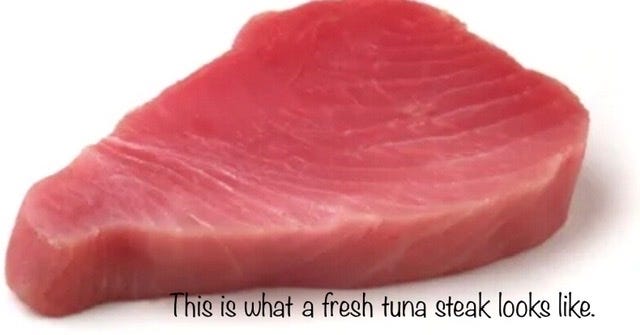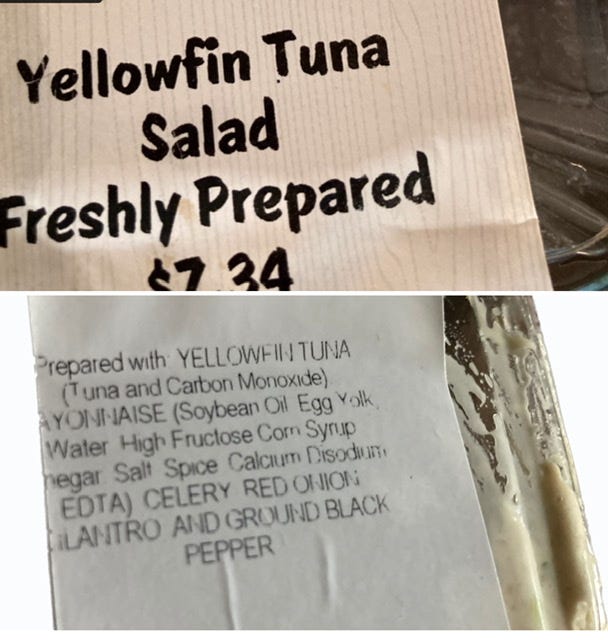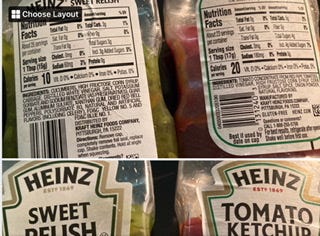There was an unexpected ingredient in the tuna salad. And not an appetizing one.
To be honest, I don’t always look at ingredient lists. I know I should, but instead, I usually eat first, look later.
The only reason I looked at this list, after it was all gone, is that it tasted so good! I thought maybe I would try to duplicate at home with the canned variety. (I know canned tuna is a far cry from fresh, but it’s always on hand.)
This tuna salad had a hint of something I thought might be relish, but it turned out this flavor was likely imparted by cilantro. However, that’s not the unexpected ingredient.
So I looked at the ingredient list. And to my surprise, one of the top ingredients was carbon monoxide. That is not a typo just in case you are as surprised as I was.
I am talking about Stew Leonard’s Yellowfin Tuna Salad Freshly Prepared ($7.34) ingredient list.
To be fair, I love Stew Leonard’s. It was a highlight for me when we moved to Brewster and the kids were small. They loved shopping at Stew’s. I even wrote about it as a day trip way back when I was still in the newspaper business. But this deserved some questions.
(Yes, you’ll see high fructose corn syrup is there too, lurking in the mayonnaise, but that’s no surprise. It’s in a lot of stuff, even though it has a reputation for being bad for our health. At bottom, I will share a photo of a couple products with high fructose corn syrup that I eat all the time. I just like them.)
But getting back to the tuna, using carbon monoxide is evidently common industry practice. It keeps fish looking fresh. But this means it can also make it difficult for the consumer to judge the freshness of the fish by its color.
Here it is perfectly legal. In Europe, it is evidently more controlled, at least according to info at packaginglaw.com.
From that article:
There is no specific legislation on the European Union (EU) banning the use of carbon monoxide (CO) as a food contact material; however, it is not authorized as a food additive in the EU. In response to a request to use CO in tuna fish, the EU's Standing Committee on the Food Chain and Animal Health (SCFCAH) in 2003 expressed concern that consumers could be misled as to the freshness of the product and concluded that CO "would fall under the definition of a food additive and was thus not recognized."
Two other sources follow.
From the USDA, specifically the National Institute of Food and Agriculture on an assessment of a study they did in partnership with the University of Florida in 2006:
Non Technical Summary
Recently some seafood processors/importers have introduced the use of carbon monoxide (CO) and filtered smoke (FS) to stabilize red muscle color prior to freezing. These processes have stirred considerable controversy due to concerns that CO/FS treated products could mask underlying seafood safety problems as color is significantly stabilized. CO/FS processing is currently legally practiced in the US and internationally on products entering the US market. . .Outputs
(1) The safety and quality effects of treating various seafoods (tuna, mahi, snapper, tilapia, mackerel etc) with various levels of carbon monoxide (CO) and filtered wood smoke (FS) was investigated in detail. Our work shows that there is a time dependent effect of the treatment on fish quality. Our investigations showed that CO and FS (to a lesser extent) influences red color of fish muscle, with 100% CO in many cases stabilizing the red color beyond point of spoilage. Red color of FS treated fish faded before spoilage was evident.
Go here for more info on that.
And from the Hawaiian Fresh Seafood website:
Carbon monoxide treated fish, (aka tasteless smoke, filtered wood smoke, CO treated) refers to a process by which tuna loins are treated with the gas to prevent oxidation and thereby alter the cosmetic appearance of the meat. Normally, a fresh piece of tuna will lose its red color and turn brown over a period of a few days when exposed to the air. The same piece when treated with CO retains an artificial watermelon red appearance indefinitely. So treating tuna with CO not only brightens the color of the meat, but it also allows the meat to retain its “fresh-looking” color even after it begins to deteriorate.
Here's a few things to keep in mind. . .
To get an answer as to why this might be in the tuna salad, I wrote to the media department at Stew’s.
Here’s the reply from Meghan Powers Bell, a director of Public Relations, when I contacted her with a query as to why it’s in there.
I spoke further with our seafood team. The vendor we buy tuna from is one that we’ve worked with for 35+ years without any issues. It’s an AAA-rated product for quality. Because Stew Leonard’s sells 80% fresh food, our team is excellent at buying only what we need and making only what will sell that day. Our team furthermore has practices in place to ensure that the tuna fish salad that we sell here at Stew’s is fresh and that the carbon monoxide is not masking a spoiled product. I hope this helps clarify!
So do I keep buying it? I’m thinking about it, and I trust Stew’s, so maybe the answer is yes.
But I tell you what: I will sure be looking more carefully at the labels of a lot more products from here on in.
What are you going to do?
And as to those other products that use high fructose corn syrup, here’s a photo of two I can’t give up. I hope it’s not killing me.




D: I wonder if Stew's will consider making a fresh tuna salad. I'm surprised too. Your content is rich. The high fructose corn syrup situation is grim in America. I don't use condiments unless they are homemade but I have someone in my home that. makes them. They are unavoidable mostly. But as you point out Europe has different food standards. It's fairly typical to eat at restaurants where you'd have to ask for them; and Netherlands for instance where mayo on fries is a local favorite; you'd get homemade mayo. Food supply has always fascinated me.
Wow! I was so pleased to find your blog, specifically, about Stew Leonard’s tuna salad with the second ingredient after tuna being carbon monoxide. While non-toxic in the quantity used to maintain a fresh look, and although Stew Leonard’s management tries to reassure you that they would never sell unsafe food under the guise of fresh, wholesome food, I call it quits on their tuna, their fish and their raw meats. I even noticed that the water that their fresh herbs stems were sitting in was a milky color so, no thanks. I am a lazy consumer and I generally like SL’s quality, but I will reconsider going an extra mile and paying more for fresher products that are treated with more respect. I am not a “your body is your temple” person at all, but if something makes me queasy in the store (the idea of eating chickens treated with ammonia, meat and fish with carbon monoxide, and herbs that need a fresh bath) I am now a convert to seeking a better way. Thanks for your research and awareness.